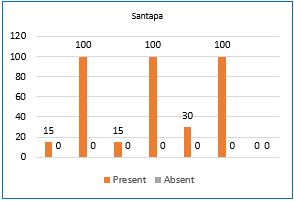A randomized controlled comparative clinical trial on Jwarahara effect of Mukkaamukkatukaadi Syrup with Kiratatikta Syrup in Febrile Children
DOI:
https://doi.org/10.21760/jaims.7.7.6Keywords:
Mukkaamukkatukaadi syrup, Kiratatikta syrup, Jwara, FeverAbstract
Ayurvedic classics have described many diseases amongst which Jwara stands first because of its uniqueness to make everyone suffer, since birth to death. Jwara being one of the commonest symptoms which accompanies almost all constitutional diseases has been coined with the term Rogadhipathi. Fever is defined as temperature in rectum more than 100.4°F (38°C), in oral cavity above 99.5°F (37.5°C) or in axilla above 99°F (37. 2°C). If we don’t treat fever in its earlier stage, there will be more chances of hyperpyrexia which may cause febrile convulsions which leads to brain damage. Therefore, it is necessary to control fever at its earlier stage. One such Jwarahara formulation is Mukkaamukkatukaadi Gulika and Kiratatikta which is converted into syrup form to overcome the palatability issues. A sample size of 30 patients was selected by simple random sampling method and 15 patients were allotted in two groups. It was planned to compare the result between Mukkaamukkatukaadi syrup in Group A study group for STG and LTG and Kiratatikta syrup in Group B control group for STG and LTG. On STG comparison, the difference in mean in Group A and Group B were 0.49,0.44 before treatment changed to 0.96 and 0.98 after treatment respectively. On LTG comparison, the difference in mean in Group A and Group B were 0.49, 0.44 before treatment changed to 2.02 and 1.96 after follow up respectively. This depicts both the formulations effective when consumed for longer duration. From the results and observations it can be concluded that Group A and Group B are equally effective and equally significant on reducing the temperature in both STG and LTG. No adverse drug reaction was found during the study.
Downloads
References
Paul Vinod, Bagga Arvind. Ghai Essential Paediatrics. 7th Ed. New Delhi: CBS Publishers & Distributors Pvt Ltd; chap 9 ,2009. p. 181.
Patil J.Pravin, Comparison of Jvarahara (Anti pyretic) Effect of Amrita and Kiratatikta in Jwara in children, 2008, Rajiv Gandhi University of Health Sciences, Karnataka.
L Aruchamy. Clinical Paediatrics (4th ed.), Disorders of Central Nervous System: Chapter 11, Wolters Kluwer (India) Pvt.Ltd, New Delhi;2019.
Prof. Yadundana Upadhyay: Madhava Nidana; The Madhukosha Sanskrit Commentary, Varanasi, Part 1 Chaukhambha Prakashana: 2013 (Chapter 25/1-5) Page No. 509.
Acharya Y.T. (ed). Sushruta Samhita of Susrutha, Uttarasthana; Jwarapratishedha Adhyaya: Chapter 39, Varanasi: Chaukhamba Surbharati Prakashan; 2012. p. 675.
D.Y.Patil, Importance of Agni in the management of Grahani disease with special reference to Lavanabhaskarachurna in Grahaniroga, Navi, Mumbai,2013.
Guyton, Arthur C., Hall John. Textbook of Medical Physiology. 11th ed. Philadelphia: Elsevier Saunders; 2006.p 807
A. Akhila Retnam., Keerthi V. R, and Reenu Mathew. “A Critical Review of Herbo-Mineral Formulations in Jwara Chikitsa.” International Journal of Health Sciences and Research 11.7 (2021): 394–406.















